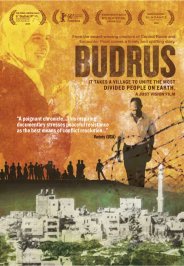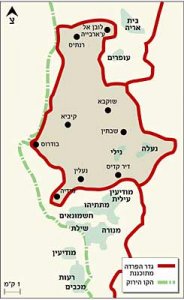A US-Israeli-Palestinian film team documents villagers’ bitter battle to save their land from Israel’s encroaching Separation Wall
 Budrus the village is in the Ramallah district of the occupied West Bank, very near the pre-1967 Israeli border. In 2004, it was one of many Palestinian villages threatened by the planned route of the separation barrier. In that particular area, nine villages were to be walled into an isolated enclave, surrounded by fences on all sides.
Budrus the village is in the Ramallah district of the occupied West Bank, very near the pre-1967 Israeli border. In 2004, it was one of many Palestinian villages threatened by the planned route of the separation barrier. In that particular area, nine villages were to be walled into an isolated enclave, surrounded by fences on all sides.
Budrus the film, produced by a US-Israeli-Palestinian team from the video group Just Vision, and directed by Brazilian filmmaker Julia Bacha, had its UK premier on the 20th and 21st of March as part of the annual Human Rights Watch Film Festival.
Too often at the end of yet another film about the occupation we are left with a sense of bitter helplessness and a debilitating pessimism. This film is worth watching because it is moving without being sentimental; and because it tells the truth about the grinding Israeli regime in the occupied West Bank but also provides an opening for action, even for hope. It is above all an activist film, in the sense that its audience can leave it both angry at the injustices described, and galvanised to support the aims of the film’s protagonists, whose determined struggle makes them hard to forget.
The 78-minute documentary, edited from 250 hours of film by Israeli, Palestinian and international activists, tells the story of a popular uprising by the villagers against the separation wall, whose planned route would have appropriated large tracts of their land. This particular uprising was led by a coalition of activists that undermines many preconceptions.
Palestinian women lead this struggle together with men; Jewish Israelis stand shoulder to shoulder with Palestinians against Israeli soldiers; and the rallying chant at demonstrations calls Hamas, Fatah and the Popular Front [for the Liberation of Palestine, PFLP] to join hands against the bulldozers that are uprooting their trees in an authentically local struggle, based on the people’s very concrete link to the land, and on a sense of insulted justice.
The result of this particular local struggle was that the route of the separation barrier was changed. But perhaps the image that most represents its spirit is that of young men and women climbing at dawn up onto the fence that is encroaching on their lands, snipping at it and swaying it back and forth until it falls to the ground. They know it will be rebuilt very quickly, and yet they are determined to defy it, and will do so again.
The filmmakers chose wisely when they decided to give the narration and the definitions of the limits of discourse to Ayed Murar, a charismatic ex-prisoner who is one of the leaders of the struggle in the village. It is he who elucidates the reasons for the choice of non-violent resistance to the wall (‘not out of politeness,’ he clarifies). It is he who is seen at the end of the film, after the route of the wall has been pushed back and away from the village’s lands, walking away from the camera to join the activists of a neighbouring village, Ni’lin, to support the same struggle in a different place, because although the local battle is won, the broader campaign continues.

The film develops slowly, from the first arrival of the bulldozers and the forces that guard them, through the early protests and mobilisation of people in the village, to the insistence of Ayed’s daughter, Iltezam, on women’s participation in the demonstrations. At all times, non-partisan grassroots struggle is stressed. Hamas, whose ideology is very far from that of Ayed, is nonetheless described by him as ‘an authentic part of Palestinian society.’ All those who choose to join the struggle, based on the wish to protect the lives and livelihood of the villagers, are welcome. In a sense, the process depicted in the film is a microcosm of a potentially broader process of change in Israel/Palestine: one based on solidarity and respect, and not on inequality, tribal identity and abuse of power.
Rare insight is provided by interviews with a border guard fighter, Yasmine Levy, who is proud of being a woman combatant but must contend with the fact that the villagers come to recognize her, learn her name, and call out to her to cross the lines. A more banal approach is represented by an army officer, who speaks platitudes in fluent American English.
The film guides its viewers through the gradual escalation of violence on the part of the border guards, and, as Ayed says, ‘they elaborated their tactics, so did we.’ The struggle grows more desperate and more bitter as beatings are replaced by tear gas, rubber-coated bullets and live firearms. In one poignant scene, after some of the activists criticise stone-throwing by youths in the village – one young boy, Hassan, is arrested during a raid. Only women are in the street at the time, and the fury and despair are palpable. One woman grapples hand-to-hand with an armed soldier, and even tries to grab his sub-machine gun. Another bends to the ground and in a moment the jeep that carries Hassan to detention is pelted with stones. No text or voice-over accompanies this scene.
When the Israelis enter the arena the balance shifts subtly. This is now no longer only a struggle for home but also a public symbol: in front of the cameras, Jews embarrass Jews and come between the soldiers and the villagers. The Israeli activists self-consciously challenge assumptions. It is a moment of danger for the film, but it manages not to fall into romanticism, because the Israeli activists are thoughtful, and wary of self-congratulation. They are also very few. It is the local Hamas activist, a teacher in the village, who expresses their role best, when he describes his surprise at the genuine commitment of Jewish activists, who stand with him against Jewish Israeli soldiers.
The border guards and army are also surprised – and displeased. They are drawn into arguments, in Hebrew. They constantly try to isolate the Israelis, in order to make sure that the only victims of any real violence are ‘the locals.’
Perhaps the most moving moment in the film is when Iltezam describes her decision, despite her fear, to move past soldiers and border guards and stand in front of a bulldozer that is uprooting the village’s olive trees. In the footage, the bulldozer (probably driven by a Palestinian) reverses and retreats before her determined silhouette.
This article may be reproduced on condition that JNews is cited as its source
Map by Ha’aretz
 This work is licensed under a Creative Commons Attribution-Noncommercial-Share Alike 3.0 Unported License.
This work is licensed under a Creative Commons Attribution-Noncommercial-Share Alike 3.0 Unported License.




